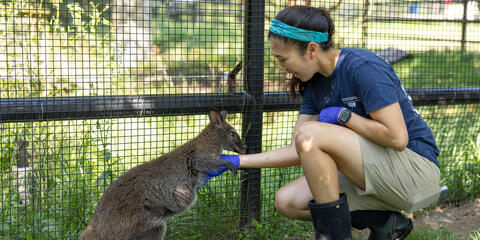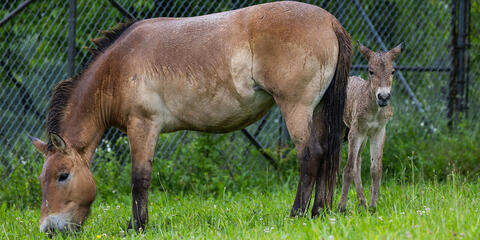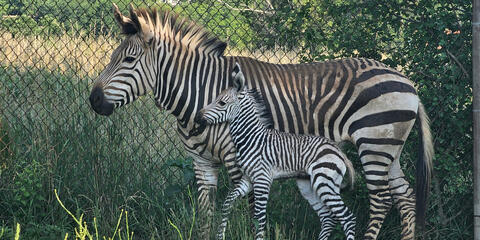Naked mole-rats are pink, nearly hairless subterranean rodents that live in burrows in eastern Africa. These surprisingly long-lived animals are one of the only true eusocial mammals; they live in large colonies in which only one female breeds and the majority of individuals spend their lives working for the colony.
Physical Description
Naked mole-rats have wrinkly pink or grayish-pink skin, which is somewhat translucent on their undersides and light purplish-brown on their backs and tails. This countershading appears to be lost with advanced age. They have short, broad heads with powerful jaw muscles and very large incisors, which they use to dig tunnels.
Size
Naked mole-rats are usually 3 inches (7.5 centimeters) long and weigh 1-1.5 ounces (28-42 grams). However, soldiers can weigh up to 2 ounces (57 grams), and the queen, who is the largest member of the colony, can weigh up to 2.5 ounces (71 grams).
Native Habitat
Naked mole-rats are found in eastern Africa, specifically in Ethiopia, Kenya, Djibouti and Somalia. They live exclusively in underground burrows and tunnels in grassy, semi-arid regions.
Lifespan
Naked mole-rats may have a life span of 10-30 years. Maximum longevity in this species is as yet unknown; animals have been in human care for as long as 30 years. This life span is unprecedented among small rodents.
Communication
They have no external ears and they have tiny eyes, which make them virtually blind. Their sense of smell is important, and they are also very sensitive to vibrations in the ground and the movement of air currents.
Food/Eating Habits
These burrowing rodents eat the underground parts of plants, particularly the succulent tubers formed by many of the plant species that grow in arid areas. They obtain all the water they need through their food; they do not drink.
When a group of mole-rats finds a large tuber (sometimes more than 1 foot in diameter), they generally bore through it, eating mainly the interior flesh while leaving the thin epidermis intact. This behavior may allow the plant to remain healthy for some time, indeed even to continue growing, thereby providing a long-term food resource for the colony.
Their diet is high in cellulose, which is difficult to digest. Naked mole-rats have high densities of gut fauna that aid in digestion. They also regularly practice coprophagy, the reingestion of feces, which allows them to maximize their uptake of nutrients from their food.
At the Smithsonian's National Zoo, they are fed apples, carrots, corn, green beans, kale and sweet potatoes as well as primate biscuits.
Social Structure
Naked mole-rats are eusocial, meaning they live in large colonies in which only one female breeds and the majority of workers (both males and females) spend their entire lives working for the colony. This is an unusual characteristic for mammals. Colony size averages 70 individuals, but colonies of up to 295 have been observed.
The animals in these groups are very closely related. Workers are generally raising their siblings, because a single queen may reign for many years. Dispersal is quite rare and inbreeding is common, which results in a high degree of genetic similarity among colony members. If a queen dies or is removed from a colony, a few females may fight to the death in order to become the new queen.
Naked mole-rats live in complex underground burrow systems. The tunnels are about 1.5 inches (4 centimeters) in diameter. Some tunnels run just under the surface of the ground, while others can be up to 6.5 feet (2 meters) deep. There is a great deal of branching and interconnection of tunnels, with the result that a colony's total tunnel length can total up to 2.5 miles (4 kilometers). Tunnels connect nest chambers, toilet areas and food sources. Burrowing is the only way these animals find food, because they do not travel above ground.
Workers dig through the hard-packed soil with their powerful, ever-growing incisors, aided by the fact that a quarter of an individual's muscle mass is involved in jaw closure. Their lips actually close behind their incisors, enabling them to dig without getting dirt in their mouths. They work assembly-line style: the front animals break through the dirt while a string of workers sweeps the soil through the tunnel system to an opening at the surface, where another worker kicks the dirt up onto the ground above its head, forming a mole hill. Mole-rats seem to do the majority of a year's digging just after the rainy season, when the normally hard ground is softened.
These eusocial rodents also cooperate to thermoregulate. Unlike most other mammals, they cannot maintain a steady body temperature. Their temperatures fluctuate with the ambient temperature, making naked mole-rats essentially cold blooded. By huddling together in large masses, they slow their rate of heat loss. They also behaviorally thermoregulate by basking as needed in their shallow surface tunnels, which are warmed by the sun.
Scientists have found that the somatosensory cortex, which is involved in the sense of touch, is unusually large. Nearly a third of it is dedicated to the animal's four, large incisors. This suggests that naked mole-rats use their teeth to sense the world around them. As they evolved unusual physical and behavioral adaptations for their underground habitat, their brain organization has evolved in parallel, resulting in an equally specialized and unusual brain adaptation.
Reproduction and Development
Only one female in a colony of naked mole-rats produces offspring; this female is called the queen. She mates with only a few of the colony's males, and these relationships can remain stable for many years. All of the other individuals in the colony aid in the queen's reproduction by caring for the pups, foraging for and providing food, and maintaining and defending the burrow system. These "workers" are physiologically capable of reproduction, but do not do so as long as they remain in the colony (which in most cases is their entire lives).
Gestation lasts about 70 days. A queen can produce a new litter every 80 days and can have up to five litters per year. Pups generally weigh less than 0.07 ounces (2 grams) at birth. The number of pups per litter is quite variable. The average is about 12 with a maximum of about 30, the largest known litter size of any mammal.
The queen nurses the pups for about a month, although they may begin eating solid food at as early as 2 weeks old. Pups also eat feces provided for them on demand by the workers. This not only provides nutrition, it also inoculates their digestive system with beneficial gut fauna.
Pups begin performing work behaviors (digging, sweeping, carrying, etc.) at 3-4 weeks old. Maturation rate is variable, but in general juveniles are physiologically capable of reproduction by age one.
Conservation Efforts
There are no immediate, major threats to naked mole-rats. They are often seen as pests, especially for sweet potato farmers because they can destroy much of a crop yield by eating the roots of plants. Due to habitat fragmentation, naked mole rats may face the threat of an unhealthy genetic population in the future.
Continued monitoring is necessary to better understand these unique animals. Minimal development and human interference exists in their present range, but if agriculture continues to expand they could be viewed as pests, as they will readily consume roots and tubers.
Distribution of colonies is patchy, although naked mole-rats do reside in multiple protected areas. They are also well represented in zoos, with well-established and maintained colonies. With a variety of unique characteristics, the species is significant to research on a number of different topics.
Help this Species
- Share the story of this animal with others. Simply raising awareness about this species can contribute to its overall protection.
- Are you a student? Did you love what you learned about this animal? Make it the topic of your next school project, or start a conservation club at your school. You'll learn even more and share the importance of saving species with classmates and teachers, too.



